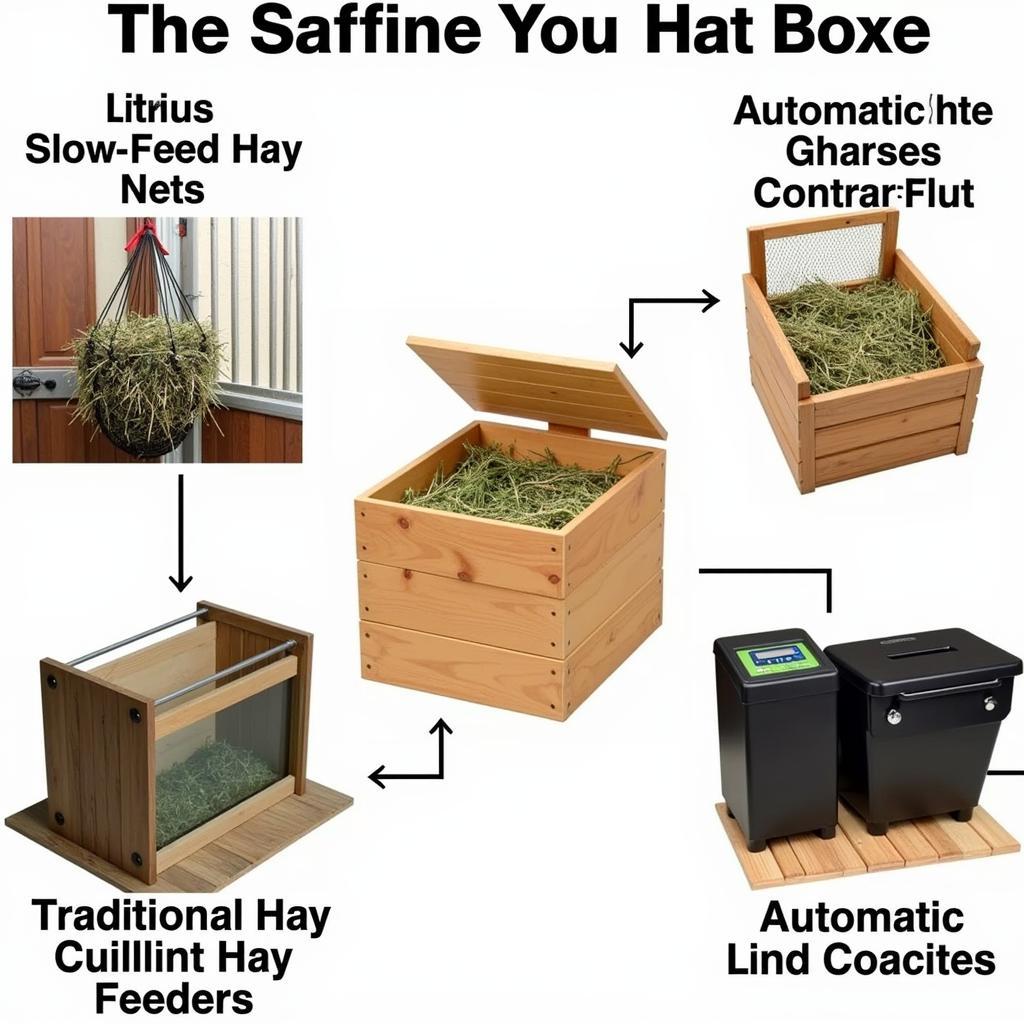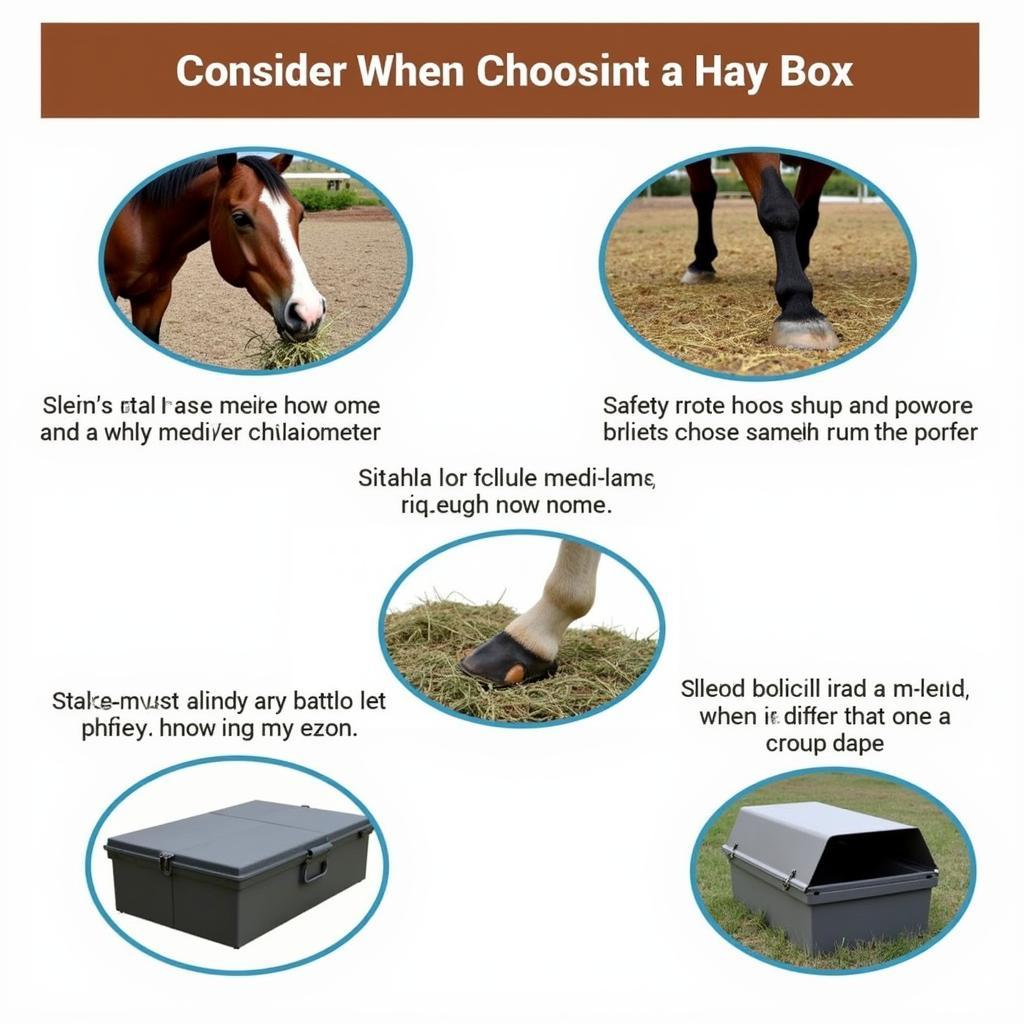Hay boxes for horses are revolutionizing equine feeding practices, offering a more natural and enriching way to provide forage. They mimic grazing behavior, promoting slower consumption and better digestion. Choosing the right hay box can significantly impact your horse’s health and well-being. This comprehensive guide will delve into the benefits, different types, and essential factors to consider when selecting the perfect hay box for your equine companion.
Understanding the Benefits of Hay Boxes for Horses
Horses are designed to graze for extended periods. Traditional feeding methods often lead to rapid consumption, increasing the risk of colic, ulcers, and other digestive issues. Hay boxes for horses slow down feeding, encouraging natural grazing behavior and promoting better digestion. This can also reduce boredom and stress, particularly in stalled horses. Furthermore, hay boxes minimize hay wastage, saving you money in the long run. They also help keep hay clean and free from contamination. They are a truly valuable investment for any horse owner.
By extending feeding time, a hay box more closely replicates the horse’s natural grazing pattern. This continuous intake of small amounts of forage helps maintain a stable pH level in the stomach, reducing the risk of ulcers.
Just after this first paragraph, I want to link to a relevant product page about mini horse hay feeders. Check out our mini horse hay feeders.
Different Types of Hay Boxes for Horses
Several types of hay boxes cater to different needs and preferences. Understanding the pros and cons of each can help you make an informed decision.
Slow Feed Hay Nets
Slow feed hay nets are a popular and affordable option. They are made from durable netting with small openings, which restricts the horse’s access to the hay. This slows down consumption and encourages chewing. They are portable and easy to clean, making them a versatile choice.
Hay Boxes and Feeders
Hay boxes and feeders come in various sizes and materials, from metal and plastic to wood. These offer a more substantial structure for holding hay and can be designed to minimize waste. Some models have features like grates or grids to further regulate hay intake.
Automatic Hay Feeders
For those seeking automation and precise portion control, automatic hay feeders are a game-changer. These devices dispense hay at predetermined intervals, ensuring a consistent supply of forage throughout the day. They are particularly useful for managing horses with specific dietary needs.
 Types of Horse Hay Boxes
Types of Horse Hay Boxes
Choosing the Right Hay Box for Your Horse
Choosing the right hay box depends on several factors, including your horse’s size, breed, feeding habits, and management style. Consider the following aspects when making your decision:
-
Size and Capacity: Select a hay box that can hold enough hay for your horse’s needs, especially if you are unable to refill it frequently. Smaller hay boxes are suitable for ponies or horses on restricted diets, while larger boxes are ideal for larger breeds or horses with free-choice access to hay.
-
Material and Durability: Opt for a durable, non-toxic material that can withstand regular use and cleaning. Metal and heavy-duty plastic are good choices for long-lasting performance.
-
Ease of Cleaning: Choose a hay box that is easy to clean and maintain to prevent the buildup of mold and bacteria. Removable nets or liners can simplify cleaning.
-
Safety Features: Look for hay boxes with smooth edges and no sharp protrusions to prevent injuries to your horse. Ensure that the design prevents the horse from getting its head or legs trapped.
 Factors to Consider When Choosing a Hay Box
Factors to Consider When Choosing a Hay Box
You can also find more information about slow feeders for horses on our website. Explore our range of slow feeder for horse options.
How to Introduce a Hay Box to Your Horse
Introducing a new feeding method should be gradual to avoid digestive upset. Start by offering a small amount of hay in the hay box alongside your horse’s usual feeding method. Gradually increase the proportion of hay in the hay box while decreasing the amount provided through the traditional method. Monitor your horse’s eating habits and adjust accordingly.
Maintaining Your Hay Box
Regular cleaning is essential to prevent the growth of mold and bacteria. Empty the hay box, remove any debris, and wash it thoroughly with soap and water. Allow it to dry completely before refilling. Inspect the hay box regularly for any signs of damage and replace it if necessary.
FAQ about Hay Boxes for Horses
- How often should I clean my horse’s hay box? Ideally, clean it at least once a week.
- Can hay boxes be used for all types of hay? Yes, but ensure the openings are appropriate for the type of hay you use.
- Are hay boxes suitable for all horses? Most horses benefit from hay boxes, but consult your veterinarian for specific concerns.
- How much hay should I put in a hay box? It depends on your horse’s size, dietary needs, and access to other forage.
- Can I make my own hay box? Yes, there are many DIY options available online.
For more information on hay slow feeders, visit our horse hay slow feeder page.
Conclusion
Hay boxes for horses are a valuable addition to any equine feeding program, promoting better digestion, reducing boredom, and minimizing hay wastage. By carefully considering the different types available and your horse’s individual needs, you can select the perfect hay box to enhance their health and well-being.
If you need assistance choosing the right hay box or have any questions, please contact us at Phone Number: 0772127271, Email: [email protected] Or visit us at QGM2+WX2, Vị Trung, Vị Thuỷ, Hậu Giang, Việt Nam. We have a 24/7 customer service team. You may also want to check out our selection of automatic hay feeder horses or learn about round pens horses.